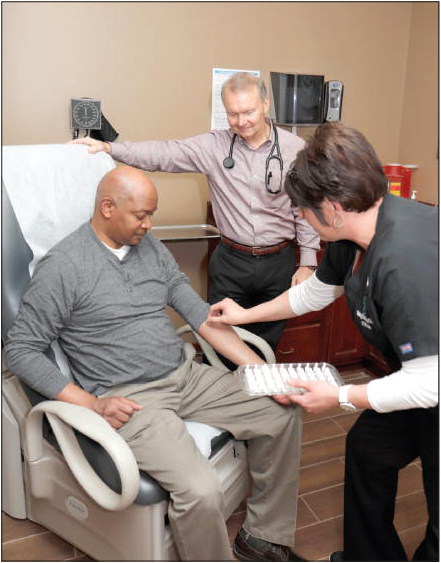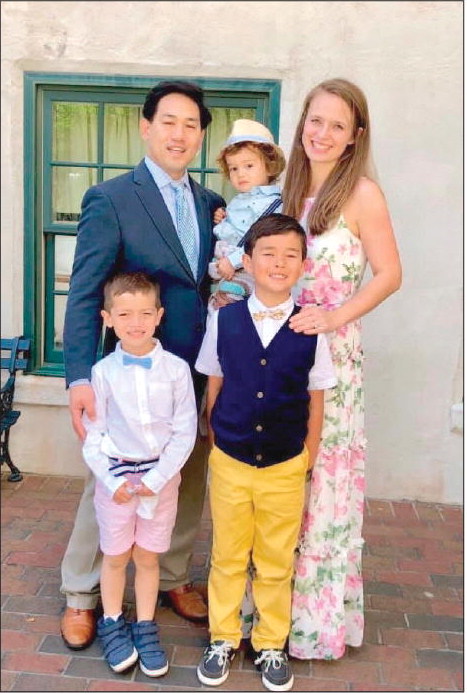Lifesaving Vaccine Now Available


By Amber Lanier Nagle Contributing Writer
Melissa Daniel Lu describes the emotional toll that being the parent of a child (or children) with a peanut allergy brings.
It was seven years ago. Melissa dabbed a small amount of peanut butter onto a cracker and gave it to her 13-month-old son, Collin. Fifteen minutes later, the toddler started rubbing his eyes and crying. She rocked him and read him books, but his restlessness continued to escalate.
“I thought he was just very tired, so I put him [down] in his crib,” says Melissa, who grew up in Claxton. “But something made me turn back around and look more closely at him, and I saw his face was beginning to swell. We rushed him to the Emergency Room, where he was treated and released.”
Melissa and her husband, Theo, soon learned that their first-born son had experienced a severe reaction to peanuts.
Today, the Lus have three boys: Collin, 8 now, is allergic to peanuts, though he grew out of his soy allergy; Connor, 7, is allergic to peanuts and green peas after outgrowing an allergy to eggs; and Madden, 3, has exhibited no food allergies.
“Our middle son had a life threatening reaction when he was around a year old requiring two epi pens [epinephrine] after eating peas,” she says. “He had been eating them for a year with no problem.” Like other parents of children with food allergies, Melissa was plunged into a world of micro-managing her family’s daily life to avoid accidentally coming into contact with the allergens — scrutinizing food labels, avoiding certain restaurants, banning her sons from certain activities and places, constantly worrying that something would trigger life-ending anaphylaxis.
“Prior to having kids with food allergies, I did not ‘get it,’” she says. “I did not understand that one crumb of an allergen could be life threatening or even fatal.” But she understands now. Her children have had some pretty significant reactions to what could be considered minor contact, and as a result, she and Theo had to establish a tableau of family rules.
“If the food doesn’t have a label, we leave it on the table, and that includes homemade treats at school,” Melissa says. “We do not eat at restaurants that serve foods containing the boys’ allergens, period. We do not go anywhere without epinephrine. If Theo or I haven’t vetted the food, the boys don’t eat it.”
She continues, “We have to do what it takes to protect our family.”
The Lus aren’t alone as they struggle with keeping their children safe from accidental exposure to peanuts. Approximately one million children in the U.S. are affected by peanut allergy, and only one out of five of these children will outgrow their allergy according to the U.S. Food and Drug Administration (FDA).
A NEW TREATMENT OPTION
“Up until now, one of the only approaches to managing a peanut allergy has been to avoid peanuts and products made from peanuts altogether,” says Geoff Conner, MD, a local doctor and allergy specialist. “But that’s easier said than done. It’s tough to avoid contact with products with peanuts every minute of every day.”
Earlier this year, the FDA approved a drug to help treat children with peanut allergies, and Dr. Conner has received certification to provide the treatment to his patients. Palforzia has been approved to treat children from 4 to 17 years old who have peanut allergies. “It is not a cure — I want to make that clear,” he says. “It is a treatment designed to ‘desensitize.’ It helps adjust the immune system so that it won’t react as severely in the case the child has an accidental exposure.”
In a year-long trial published in the New England Journal of Medicine, 67 percent of children with confirmed allergy were able to tolerate 600 mg of a peanut protein by the end of a study period compared to four percent of patients in the placebo group. “Again, the treatment isn’t designed to allow a person to eat peanuts and peanut butter,” Dr. Conner cautions. “But for some children with confirmed peanut allergies, it may help reduce the risk of a potentially life-threatening allergic reaction.”
The treatment starts in the physician’s office where the patient is closely monitored. The drug itself comes in premeasured capsules. Patients ingest controlled, increasing amounts of the drug mixed with food over a period of time.
“On the first day, we start out with administering half a milligram of a peanut protein powder mixed with a food product, and we monitor our patient for 30 minutes,” he explains. “If the patient tolerates that first dose, we administer a second dose [1 mg] and monitor for another 30 minutes. There are about five levels on that first day.”
If the initial treatment goes well, the patient takes a set dose for two weeks, then visits the doctor’s office to attempt consuming the next level, which is referred to as updosing — 3 mg daily for two weeks, then 6 mg daily for two weeks, 12 mg daily for two weeks, etc., until the patient is able to tolerate 300 mg daily for two weeks. At that point, the patient continues to ingest 300 mg each day. “If the patient gets to that last dose without a problem, the patient’s immune system will be able to tolerate a larger amount of peanut before reacting, if he or she accidentally contacts a peanut product,” Dr. Conner says. “The patient has to continue taking the 300 mg maintenance dose for it to work. He or she can never come off of it.” Not every doctor or clinic can offer the treatment. Conner has gone through extensive training.
“And our entire staff is going through inhouse training soon, and we will be ready to start treating patients shortly after that,” says Dr. Conner. “We will be the first site in the area to offer this promising treatment.”
Conner estimates that six percent of his allergy patients are allergic to peanuts. Those interested in trying the Palforzia treatment should call The Allergy and Asthma Clinic of Southeast Georgia at (912) 537- 9488.
“Food allergies, such as peanut allergies, put a significant mental, social and financial burden on the families who deal with them,” Dr. Conner says. “This is big for children who suffer with allergies and their parents. I’m happy that I have something to offer them — to give them hope.”










